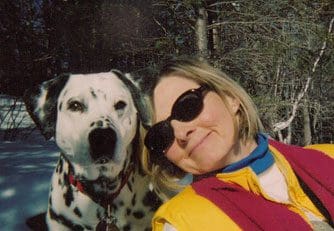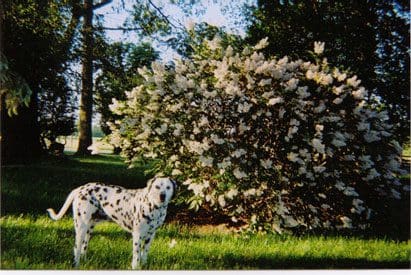Our Mascot Mickey

By Ted K. Woods
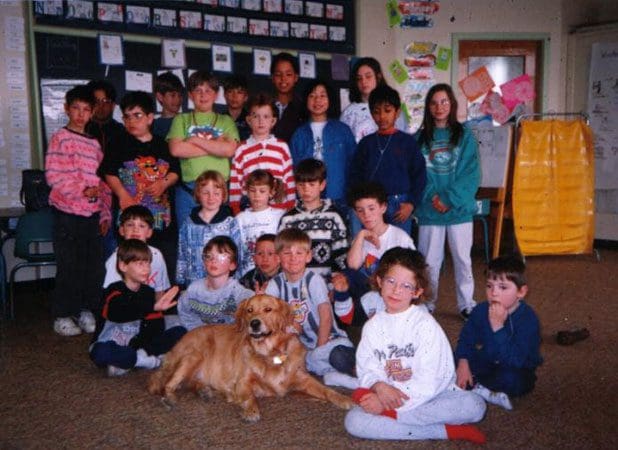
OUR MASCOT MICKEY
The Story
The story starts when “Ducat” (our golden retriever) and I were teaching hearing impaired children at the Queen Elizabeth School in Calgary how to train their dogs just using their hands for sign commands.
Imagine our surprise when the students presented us with a totally deaf, six-week old Dalmatian puppy in appreciation of our volunteer efforts. It was a challenge explaining to the children that the puppy would have to be thoroughly checked out by a vet first and if the tests came back positive (except for the hearing), we would work together to train him.
Two animal clinics examined the pup and conducted a BAER (Brainstem Auditory Evoked Response) test. The results? The puppy was perfect– except for the deafness. The kids were elated! And so the training began.
Mickey’s sign name: With your right hand, point your index and pointer fingers together to your right ear lobe and then move both fingers to your chin and tap your chin twice. Finally, form a fist with your right hand and hold it up even with your shoulder.
Mickey quickly learned his name (treats were involved!) and would sit and watch, just waiting for his next hand command.
Since there wasn’t much literature at the time about training deaf dogs, we had to innovate and try things by experimenting. It was the kids who suggested that commands be divided between the right hand and the left hand since there would be times when both hands weren’t available (such as when carrying books to school.) The commands were categorized: safety with the right hand and tricks with the left hand.

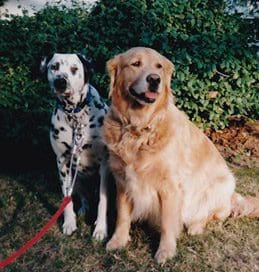
The answer was simple once we figured it out: motion with your right hand for him to come to you.
How do you call him at night when he can’t see you?
Hmm. I first suggested using a flashlight but the kids reacted signing the word, “NO!” They immediately saw the danger in that idea and explained Mickey wouldn’t be able to distinguish between a flashlight beam and a car’s headlights.
So how do you call a deaf dog at night?
The hearing impaired kids gave us the answer. You use the same command as in the daylight, but shine the flashlight down on the command.
All was well until Mickey encountered people who didn’t know about his special sign language capabilities and spoke normally using their hands to express themselves. First, Mickey would sit and watch, then dance, then sit, then dance, up, down and back up causing the person to ask, “What’s wrong with this dog?” The laughter would start. Of course, the answer was simple, “You’re talking to him!”
As more and more people got to meet Mickey, they were intrigued and wanted to communicate with him using his special sign commands. In response, we prepared a reference sheet detailing all the commands and then the training shoe was on the other foot! People found it difficult not to use their hands when speaking.
We became more proud of our “spotted wonder” every day, especially when “The Mickey” learned a new sign command.
He lived a rich life and varied life transitioning from city to farm to lakeside. Mickey quickly adapted. He enjoyed canoeing and jet-skiing. Since the noise of the engine didn’t bother him, he reveled in the fresh breeze and the water spray. When he saw his life jacket coming out of the closet, he was ready to go!
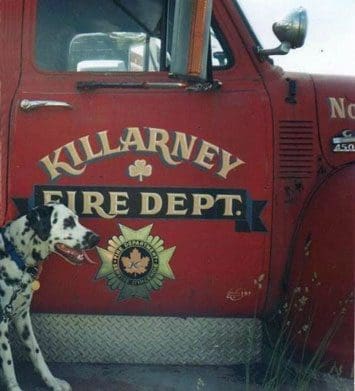
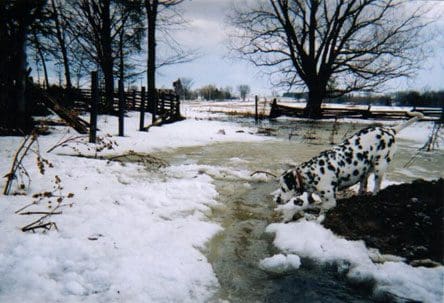
During spring melt he would chase floating sticks down the stream.
As a protective measure, we attached a bell on his collar to warn off wildlife. While the constant dingle-ling of the bells would drive us nuts at times, he wouldn’t mind at all since he couldn’t hear them.
The “Mickey” would bark once if he saw something moving and then he would look at us for validation. What was moving? What was in the trees? Once we figured it out, we gave him the “GOOD BOY” command (which was both hands quickly clapping with no sound for just two or three seconds and then give his sign name.) I swear he would smile in self-satisfaction.
Being a Dalmatian, Mickey loved to run. One of his happiest moments was when he discovered the lake was frozen in the winter and he could run flat out at top speed down the length of the bay, turn around and race back with no obstacles. Running free just for the joy of running.
Mickey had a soft spot for babies and little children. He was very gentle and patient with them and in return, the kids loved him. We got used to the neigbourhood kids trailing us whenever we took him for a walk. A common refrain was, “Can Mickey come home with me? I want to take Mickey home. Mickey loves me, I want Mickey”.
Whether it was because he was deaf, it seemed that Mickey’s sense of smell was more developed than other dogs’. He literally stopped to smell the flowers.
In spite of his handicap, Mickey lived a long and interesting life with his good buddy and frequent “interpreter”, Ducat at his side. He offered steadfast loyalty and was the best watch dog always paying attention to details.
Mickey was, and remains an inspiration. We are proud to have Mickey as our mascot.
